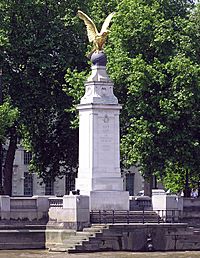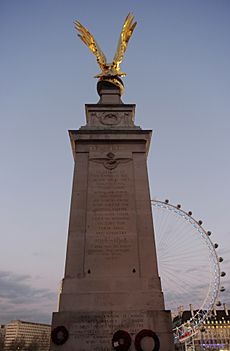Royal Air Force Memorial facts for kids
The Royal Air Force Memorial is a special monument in central London. It stands on the Victoria Embankment and remembers all the brave people from the Royal Air Force (RAF) who lost their lives. This includes those who served in World War I and other conflicts since then.
The memorial was first shown to the public in 1923. It's considered the official monument for the RAF and other air services. It's located near famous landmarks like Cleopatra's Needle and the Ministry of Defence building. Other memorials, like the Fleet Air Arm Memorial and the Battle of Britain Monument, are also close by.
Quick facts for kids Royal Air Force Memorial |
|
|---|---|
| Great Britain | |
 |
|
| For RAF personnel killed in the two world wars | |
| Unveiled | 1923 |
| Location |
London, WC2
United Kingdom |
| Designed by | Sir Reginald Blomfield (monument), William Reid Dick (eagle) |
|
Inscriptions include: "Per ardua ad astra" and
"I bare you on eagles wings and brought you unto myself" (Exodus 19:4) |
|
Contents
Building the Memorial
Why the Memorial Was Needed
After World War I ended, people wanted a way to remember the airmen who died. A special group was formed in 1919 to plan an RAF memorial. This group was led by important figures like Lord Hugh Cecil and Air Chief Marshal Sir Hugh Trenchard.
Raising Money and Design
Money for the memorial was collected by the RAF Memorial Fund. This fund is now known as the RAF Benevolent Fund. The memorial was designed by a famous architect named Sir Reginald Blomfield.
When it Was Unveiled
The memorial was officially shown to the public on July 16, 1923. The Prince of Wales, who later became King Edward VIII, unveiled it. Every year on Battle of Britain Day, September 15, the head of the RAF places a wreath at the memorial. This is a way to honor those who served.
What the Memorial Looks Like
The memorial is a tall, tapering stone pillar called a pylon. It's made from Portland stone, which is a type of white limestone. At the very top of the pylon, there is a golden eagle with its wings spread wide. This eagle is a symbol from the RAF's badge. It faces east, towards the River Thames and France.
The eagle was sculpted by William Reid Dick and cast by a company called Parlanti. Sir Reginald Blomfield used similar pillar designs for other war memorials, like those in Torquay and Luton.
Messages on the Memorial
The memorial has important messages carved into its sides. These messages face both the Embankment and the river. More messages were added after World War II. These were unveiled by Sir Hugh Trenchard on September 15, 1946.
RAF Motto
Around the top of the pylon, you can see words from the RAF motto: "Per ardua ad astra". This means "Through adversity to the stars." This motto was first used by the Royal Flying Corps in 1912.
Dedication to Service Members
On the side facing the Embankment, the words "Per Ardua" are highlighted in gold. Below this, there is the RAF symbol and a dedication. It says: "IN MEMORY OF ALL RANKS OF THE ROYAL NAVAL AIR SERVICE ROYAL FLYING CORPS ROYAL AIR FORCE AND THOSE AIR FORCES FROM EVERY PART OF THE BRITISH EMPIRE WHO GAVE THEIR LIVES IN WINNING VICTORY FOR THEIR KING AND COUNTRY 1914–1918".
A Quote from the Bible
Below the dedication, there is a quote from the Book of Exodus (chapter 19, verse 4) in the Bible. It reads: "I BARE YOU ON EAGLES WINGS AND BROUGHT YOU UNTO MYSELF".
Remembering World War II
Further down on the base, another message was added to remember those who served in World War II. It says: "THIS INSCRIPTION IS ADDED IN REMEMBRANCE OF THOSE MEN AND WOMEN OF THE AIR FORCES OF EVERY PART OF THE BRITISH COMMONWEALTH AND EMPIRE WHO GAVE THEIR LIVES 1939–1945".
Perpetual Memory
The side of the memorial facing the river also has the RAF symbol. It says: "1914/ 1918/ IN/ PERPETUAL/ MEMORY/ 1939–1945". This shows that the monument was made to remember all air services from both World War I and World War II.


